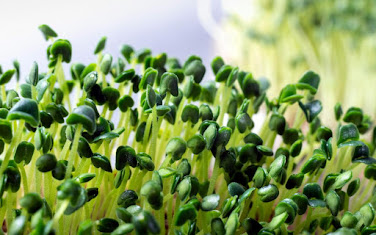ALL THAT YOU NEED TO KNOW ABOUT
MICROGREENS
What is a MICROGREEN?
Microgreens, tiny leafy vegetables, are becoming a new cooking ingredient.It is a young, delicate green with two fully developed cotyledons that look like the first pair of true leaves or partially developed.They are young, delicate leaf green cotyledons, presented in a useful palette of colors, textures, and flavors.Microgreens are a new class of edible vegetables that are harvested when the first leaf is fully bloomed, but before the actual leaves appear.
Microgreens, also known as "vegetarian confetti", are various small and delicate plant seedlings used to add variety and color to salad mixes.
WHICH SPECIES ARE GROWN AS MICROGREENS?
Microgreens can grow from a variety of seeds.
The most popular varieties are obtained from the seeds of the following plant families:
Cruciferous: Cauliflower, broccoli, cabbage, watercress, radish and arugula.
Apiaceae: dill, carrots, fennel and celery.Amaryllidaceae: garlic, onion, leeks.
Amaranthaceae: amaranth, quinoa, beets, beetroot and spinach.Pumpkin family: melons, cucumbers, pumpkins.
Asteracae: lettuce,chicory, endive .
Grains such as rice, oats, wheat, corn, and barley, and legumes such as chickpeas, beans, and lentils are sometimes also grown in micro-vegetables.
HIGH DEMAND MICROGREENS
Beet, amaranth and chard microgreens are in demand when a splash of It takes color to season a dish, but it is also difficult to grow.They are commonly used as side dishes and are also an important ingredient in salads.
WHEN IT WAS FIRST UTILIZED?
Microgreens originated in the San Francisco area in the late 1980s, when they appeared on chefs' menus.With its exotic varieties and bright colors, micro-vegetables are a new and widely used ingredient.in sandwiches, salads, and garnish to enhance the sensory properties of a variety of dishes. As such, microgreens as specialty food products have gained increased attention in food markets and restaurants.
WHERE THEY CAN BE GROWN?
Microgreens can be grown in greenhouses, in soil, or soilless systems, by using organic or non-organic, solid or hydroponic growing media.
The choice of nutrient medium is one of the most important aspects in the production process of micro-plants as a nutrient mediumone of the main costs of production, plays a major role in determining the yield and quality of microgreens, and influences the environmental sustainability of the production process Microgreens can be grown in greenhouses, in soil, or soilless systems, by using organic or non-organic, solid or hydroponic growing media.
The choice of medium is one of the most important aspects in production.The micro-greening method, since the culture medium is one of the main production costs, it plays an important rolePlay a role in determining the yield and quality of micro-vegetables, and affect the ecological sustainability of the production process.
Since ideal growing media for microgreens are provincially available and comparatively inexpensive, many local farmers engage in producing microgreens in greenhouses.
Moreover, no previous studies have specifically investigated the differences in sensory attributes among commercial, regional soil-grown, and hydroponically grown microgreens.
ARE THERE ANY NUTRIENTS IN MICROGREENS?
Ascorbic acid is the most common type of phytochemical, with a concentration of 41.6 to 139.8 mg/100 g. Roselle microgreens were found to have the highest mean content, followed by French basil, radish, and carrot microgreens.A similar range of total ascorbic acid content was found in 25 commercial micro-plant species (204–147 mg/100 g FW) and 30 varieties of Brassicaceae microgreens (32.9–120 mg/100 g FW) . The highest lutein content among the culinary microgreens was obtained in carrots, which had2.7 levels higher than spinach (less lutein). The values were following those obtained in mustard, beet, and parsley microgreens (53.64–122.91μg/g FW, equals to 5.4–12.3 mg/100 g FW). Consumption of 3–5 mg lutein per day has been reported to reduce the risk of early, intermediate, and advanced age-related macula degeneration (AMD) . Based on the USDA reference amount customarily consumed for green leafy vegetable (85 g/day) , all the culinary microgreens contribute 7–20 mg lutein daily, making them remedial ingredient which can aid in the management of AMD.
Similar DPPH RSA was reported in common and Tartary buckwheat microgreens with IC50values of 239.7μg/ml and152.5μg/ml, respectively .Fennel microgreens, an aromatic species, had the highest ferric reducing power with a FRAP value of 38.7μmol FE/GFW; 575.4μmol FE/g DW, followed by roselle microgreens (36.3μmolFE/g; 519.3μmol FE/g DW), a vegetable species is an antioxidant capacity assay that uses Trolox as a standard.This test is commonly used to measure the antioxidant capacity of foods, beverages, and supplements containing polyphenols.)Roselle microgreens, a vegetable species from the Malvaceae family, were also found to contain the highest ASA, TPC, and TFC concentrations in the present study. Studies have also reported good amounts of phenolics, flavonoids, saponins, alkaloids, and tannins immature roselle leaf extracts.
Carrot microgreens had the highest lutein content, while fennel microgreens the highest chlorophyll content, FRAP. All the studied microgreens were found to have higher or comparable OPCI and PCI than spinach mature leaves. Based on OPCI and APCI, the micro-greens high in antioxidant phytochemicals and antioxidant potential were roselle (vegetable species), fennel (aromatic species), French basil(aromatic species), and sunflower (oleaginous species).
While their nutrient contents vary slightly, most varieties tend to be rich in potassium, iron, zinc, magnesium, and copper.Studies comparing micro greens with more mature greens show that the nutrients in micro greens can be up to 9 times that of mature greens.
CAN IT BE CONSUMED BY PATIENTS WITH DIABETES AND CHRONIC DISEASES?
YES !! IT CAN BE AND IT HAS BENEFITS TOO
Heart disease: Micro vegetables are rich in polyphenols, which are antioxidants that can reduce the risk of heart disease.Animal studies have shown that micro-vegetables can reduce the levels of "bad" LDL cholesterol and triglycerides.
Alzheimer's disease: Foods high in antioxidants, including foods high in polyphenols, may be associated with a lower risk of Alzheimer's disease.
Antioxidants in diabetes can help relieve stress because stress interferes with the normal flow of sugar into cells.Certain types of cancer. Fruits and vegetables rich in antioxidants, especially those rich in polyphenols, can reduce the risk of various cancers.Micro-vegetables rich in polyphenols can also produce similar effects.
OTHER BENEFITS
Improving Digestion Healthy foods that possess properties to encourage the natural growth of beneficial gut bacteria are called Prebiotics.Cruciferous microgreens (broccoli and cabbage) are prebiotics proven to improve the body’s natural resistance to invading pathogens.
Lowering Cholesterol Researchers found that eating red cabbage microgreens can lower LDL cholesterol and triacylglycerol levels. Their data further suggested that microgreens can help to control weight and may protect against cardiovascular disease.
Although this seems promising, remember that the number of studies that directly measure the impactThe use of micro green plants in these medical facilities is limited, and they cannot be found in humans.
DIFFERENCES BETWEEN MICROGREENS, VEGETABLES AND SPROUTS?
In fact, not only are they different in appearance and taste, but they are also grown in different ways. Another difference is that microgreens and sprouts are technically at different parts of the growing cycle of any given vegetable/herb.
All plants start as a seed. Think of the seed as an embryo. Seeds are embryos that come with a protective shell, which is called the seed coat, and it contains Indoor plants need to get rid of all the wonderful nutrients and vitamins of this layer, among other things protective coating and the embryo is the endosperm, which wraps around the embryo and gives the baby
Let's talk about Germination . Then there is budding.Bud is the germinated seed.This means that the "sprout" of the seed wakes up from sleep and becomes a real living plant.With the nutrients stored in the seed, the embryo develops its torso
.Imagine bean sprouts-the stems of seedlings!If you let the germinated seeds germinate, they will eventually grow into mature plants.At that time, you will have fresh and refreshing bean sprouts.
People often sprout in water.To prevent mold, these seeds are washed once or twice a day.The bean sprouts grow very fast and can be harvested in about four to six days.Little light and food are needed for germination (in fact, no need at all).
The bean sprouts are delicious and healthy. A word of admonition, though: sprouting seeds require a certain amount of humidity, a condition in which bacteria thrive.
According to Food safety.Since 1996, at least 30 food-borne disease outbreaks have been reported to the government. Bean sprouts are used in a variety of dishes mainly because of their contrasting texture rather than their visual appeal. Their taste is relatively mild.
Tiny Baby Microgreens
Microgreens is the result of cotyledon growth when the plant grows its first leaf. The "cotyledon" usually becomes the first leaf of the plant.They are formed in seeds and when they appear they are like leavesThey perform photosynthesis: both convert light energy into chemical energy necessary for plant growth.The leaves and stems are usually eaten, and the seeds are more likely to germinate in the soil or peat instead of germinating in water like buds.Soil provides nutrients for plants.They take longer to grow, one to three weeks, depending on the plant.Unlike seedlings, seeds cannot be eaten because they are in the ground.The microphone also needs sufficient light and good ventilation, just like any plant can be grown indoors or outdoors.Microgreens should not be confused with baby vegetables. Baby vegetables are not suitable for any growth stage; these are foliage plants that are harvested before they actually mature.So you have your first real leaves, but they are not as big as imagined.
In terms of taste, miniature vegetables are larger than their younger siblings (sprouts) and older siblings (tender vegetables or mature vegetables). Many studies have also shown that, depending on the variety, micro-vegetables have higher nutritional value than their mature counterparts.So here is the difference between micro vegetables and bean sprouts.
Miniature vegetables are grown on the ground; bean sprouts sprout in the waterGreen leaves and stems can be eaten; you can eat the seeds of "stems" and bean sproutsDepending on the variety, it takes one to three weeks for micro-vegetables to grow; bean sprouts grow out in less than a weekMicrogreens are packed with flavor and are often used as garnishes; sprouts are great for crunch.
What are the Limitations?
KEYWORDS
TPC- TPC activity is the process to figure out the amount of phenolic content in the samples.Phenolic compounds in plants have redox properties that enable them to act as antioxidants.
FRAP- Ferric reducing the ability of plasma (FRAP, also Ferric ion reducing antioxidant power
DPPH RSA -The DPPH essay is used to predict antioxidant activities by a mechanism in which antioxidants They inhibit lipid oxidation, thereby eliminating DPPH free radicals, thereby determining the ability to eliminate free radicals.Due to the relatively short time required for analysis, this method is widely used.
ASA -The production of hydroponic leafy vegetables rich in ascorbic acid (ASA) and low nitrate content is critical for the improvement of the cultivation systems towards the production of high-quality products for the consumers.
TPC -Total phenolic content (Presence of considerably good amount of phenolics may contribute significantly to the antioxidant properties)
TFC-Total flavonoid content.
APCI-The Antioxidant Potential Composite Index
OPCI-An Overall Phytochemical Composite Index (OPCI).
1. https://usdasearch.usda.gov/search?query=MICROGREENS&op=Search&affiliate=www.nal.usda.gov( MAIN PAGE)
2. https://pubag.nal.usda.gov/catalog/5682411
3. https://pubag.nal.usda.gov/catalog/6892485
4. https://pubag.nal.usda.gov/catalog/6892517
5. https://reader.elsevier.com/reader/sd/pii/S2666154320300272?token=71E0DD5B72352F048BB457E23E7883A590DECAD0AB1A3039847C8BD2208B7091A42003AA2B78A46B4ECAC5B2EDB46D94&originRegion=eu-west-1&originCreation=20210704152453
Comparative evaluation of phytochemical content, antioxidant capacities and overall antioxidant potential of select culinary microgreens
6. https://reader.elsevier.com/reader/sd/pii/S2666154320300326?token=4C4462F7F1688BB49CE86721A469128C7F488BC0779EB9137D0094133AC6E7F14EBF7B485C9BA25D59ED3F4AB64E1689&originRegion=eu-west-1&originCreation=20210704144633
Consumers’ acceptability and perceptions toward the consumption of hydroponically and soil grown broccoli microgreens
7. https://www.urbancultivator.net/microgreens-vs-sprouts/
8. https://www.thebetterindia.com/225337/how-to-grow-microgreens-expert-home-steps-tips-seeds-superfood-india-ang136/#:~:text=Spread%20the%20seeds%20densely%20on,with%20water%20twice%20a%20day.
9. https://www.microgreenscorner.com/common-microgreen-problems-and-how-to-fix-them/
10..https://www.quora.com/What-is-the-demand-for-microgreens-in-India-Will-they-be-viable-to-grow-commercially
11. https://sustenance.co.in/how-to-grow-microgreens-in-india/
12. https://microgreensworld.com/why-eat-microgreens/
13. https://www.healthline.com/nutrition/microgreens#risks
14. https://www.aboutmicrogreens.com/advantages-and-disadvantages-of-microgreens/
IMAGE SOURCE
1.https://www.theweek.in/leisure/lifestyle/2020/06/12/microgreens-grow-your-own-food-kitchen-window.html
2. https://www.igrow.news/igrownews/teeny-greenie-farming-local-farmer-producing-nutrient-filled-microgreens
3. https://www.medicalnewstoday.com/articles/316075
4, https://www.uncommongoods.com/product/organic-microgreens-hydroponic-kit
5.https://homesteadandchill.com/grow-microgreens/
6. https://villagestory.co.in/all-about-microgreens/
7. https://growhotpeppers.com/what-exactly-are-microgreens/
8. https://regencyhealthcare.in/gastroenterology/healthy-habits-for-digestive-health/
9. https://economictimes.indiatimes.com/wealth/personal-finance-news/why-farmers-fear-the-new-farm-bills-view/articleshow/78461303.cms










Comments
Post a Comment